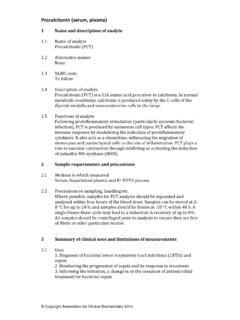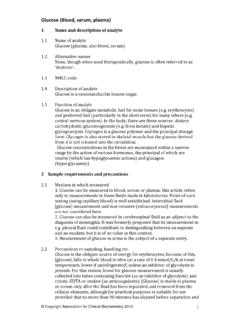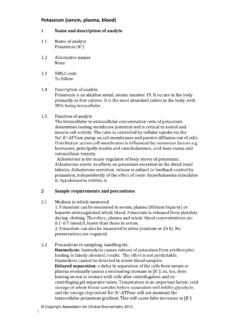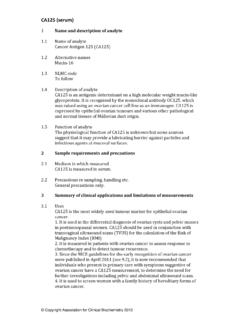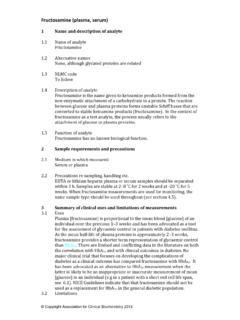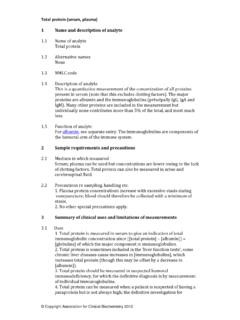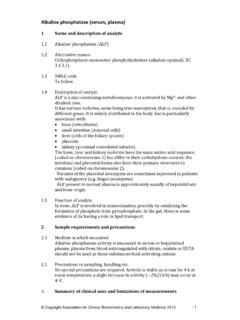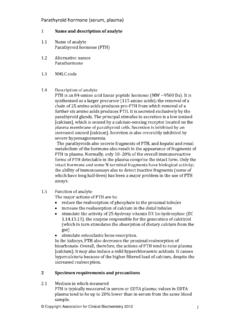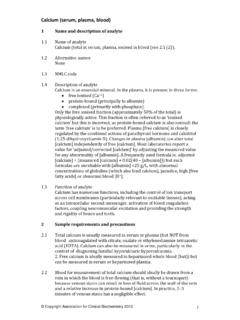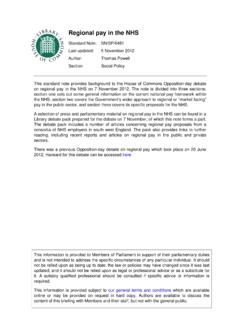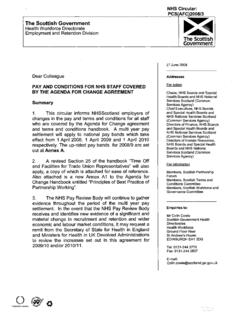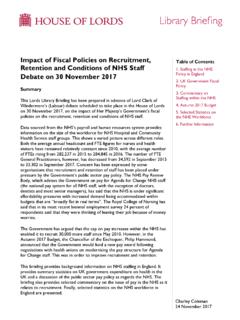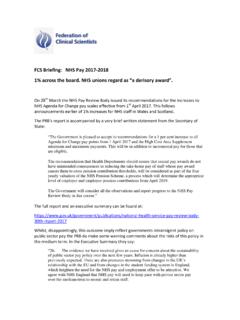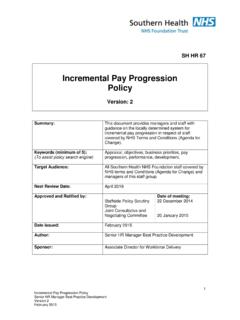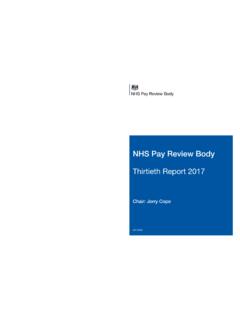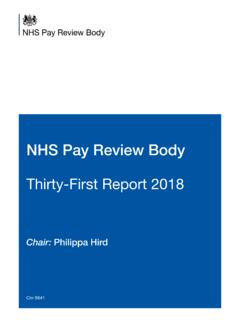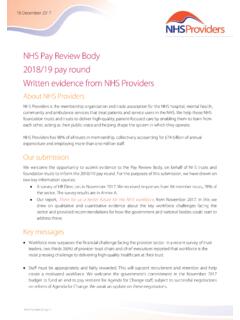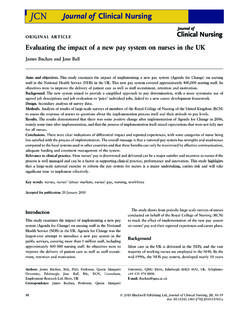Transcription of FCS Briefing - 3 year NHS pay Framework Agreement
1 FCS Briefing 2018-2021 nhs pay for Agenda for Change staff - 3 year Framework Agreement FCS Members, The flurry of media attention to the announcement of the Framework Agreement on nhs pay has subsided. Now is the time for you, those directly affected, to consider the offer, to learn about and understand the background and details and to indicate via your FCS representatives whether you wish your union to accept it. The Framework Agreement offer is multi-faceted and does deserve some attention. It is set against background of the government policy of reducing the deficit from the 2008 financial crisis in part by public sector pay restraint. Although the headlines indicate the breaking of the 1% pay increase cap , pay restraint remains the underlying government policy. The joint unions and employers timetable is: March 21st The Framework Agreement released for consultation; March & April Release of documentation, pay journeys (for current staff) and calculators to help you understand the impact of the Agreement ; May Unions and employers determine their members responses; June NHS Staff Council determine whether the Agreement is accepted; July If accepted increased pay into pay packets with back pay to April 2018 thereafter.
2 This Briefing describes the content of the Framework Agreement as it applies to Agenda for Change staff in England however the devolved administrations have indicated that would wish to replicate it if it is accepted in England. Joint union documentation can be found at Background and Context: Why restructure? The AfC terms, conditions and pay arrangements came about in 2004 following major legal challenges to the former Whitley system where each individual group had its own terms and scales. The AfC system with harmonised terms and conditions, its 9 pay bands supported by the Job Evaluation system and cost of living uplifts determined through the nhs pay review body system has generally served well. However the 2004 Agreement was always regarded as work in progress . Subsequent legal challenge supported the general principles of AfC as an equal-pay compliant system but criticised: The lack of rationality of length of some scales (especially bands 6 & 7 with 9 points) if they really represent the time taken to work into the full rate for the job ( top of band); The number of overlap points (3 between bands 5&6 and 4 between 6&7).
3 Austerity and restrictions to public sector pay increases frustrated discussions towards reform. The situation has eased somewhat leading to the model in the Framework Agreement . Unions were adamant that any cost implications be fully funded to avoid further pressures on the already stressed health service and its staff. Thus HM Treasury approval was needed. The objectives of the 3 year deal are: To increase starting salaries to help NHS attract and recruit staff; To help NHS retain staff by providing increases in basic pay for those already at top of pay bands above those expected under the current system of 1% cost of living increases; To support existing staff with more rapid pay progression supported by explicit standards. Elements of the Framework Agreement The result of many weeks of negotiation and impact modelling by unions, NHS Employers and the Department of Health and Social Care culminated in the approval on 21st March of funding over the 3 years of the transition period.
4 The Framework Agreement is multi-faceted and rather complex. The components are: Removal of all overlap points from the bottom of pay bands ( where there is overlap with the top points of the band below); Radical reduction in the number of points in a pay band with bigger increments but length of stay on each point is 2 to 5 years rather than current 1 year step; A recognition that the top point of bands is the rate for the job ; The new pay bands will be in place (for all except bands 6 & 7) in 2020-2021 and for all in 2021-2022; For those not already at top of band in March 2018 there is a step-wise transition as old pay points are removed. This will incorporate cost of living increases; For those already at top of scales there will be cost of living increases each year 2018-19, 2019-20, and 2020-21. These increases are: o 3% from 1st April 2018; o from 1st April 2019 plus a one off cash payment of a further (bands 8D & 9 get the same additional cash amount as 8C).
5 This cash payment is not consolidated nor pensionable; o from 1st April 2020 (8D & 9 again get the same cash value as 8C). The system to establish increases once the new pay band structure is in place from 2021 will be determined. For 8C, 8D & 9 the system of re-earnable points, as first introduced in 2013, continues but only once the top of band has been attained. From year 7 in post onwards 5% or 10% is vulnerable subject to performance. Diagrammatically: 1. Bands 6& 7 2. Bands 8A & 8B Band 6/7: 2017-18 9 points, 8 years to top of band. 9 8 7 6 5 4 3 2 1 Overlap with Band 5/6 Band 6/7: 2021-2022 Top point 2nd point Start point 3y 2y Band 5/6 2018-19 to 2020-2021 Transition 1. Cost of living & restructure (removal of points) increases on 1st April 2. Pay progression on your normal incremental date 3. Bands 8C, 8d & 9 Rather than go into great detail here I refer you to the documentation about the Framework at: 2017-18: Band 8A/B 6 5 4 3 2 1 Band 7 Overlap points 1 & 2 2021-22: Band 8A/B Top point Start point Band 7 5y 2018-19 to 2020-2021 Transition 1.
6 Cost of living & restructure (removal of points) increases on 1st April 2. Pay progression on your normal incremental date 2017-18: Band 8C,D,9 6 5 4 3 2 1 Top 2 points removable Overlap 2021-22: Band 8C,D,9 Top point Start point 5y 5% or 10% removable 2018-19 to 2020-2021 Transition 1. Cost of living & restructure (removal of points) increases on 1st April 2. Pay progression on your normal incremental date and These sites give pay journeys as the precise progression varies considerably depending on your current (2017-18) pay point. This is inevitable when making such radical reform to the pay point structure. Note that the salary in each future year on those tables is attained in two steps: The cost of living and restructure component which will happen on 1st April each year; Progression up the pay band which will happen on your normal incremental date. At some points, where old points have been removed, this will not result in a further pay increase on incremental progression.
7 However the 1st April increase at these points will already have been substantial. The point by point journeys for bands 6 to 9, relevant to FCS members, compared with the same journey assuming a 1% public sector increase is given in the table below. In reading the journeys simply find your 2017-18 band and pay point and read horizontally across the line. Contrary to earlier reports in parts of the media unsocial hours arrangements (for bands 4 to 9) and annual leave entitlements are unchanged by the Framework Agreement . High Cost Area Supplements (HCAS) remain in place at the same 20%, 15% & 5% rates for inner London, outer London and fringe locations. The minimum and maximum cash values are uplifted broadly in line with the top of bands. See Table 2 below. What if the Framework Agreement is rejected by NHS staff? NHS unions, other than GMB, are recommending acceptance of the Framework Agreement however the final decision lies with you, the members. If the Framework is not accepted then the fall back is the year-on-year nhs pay review body system.
8 All parties have submitted evidence in 2017 towards the 2018-19 process. The staff-side submitted a claim for an award, the government argues the need for continuing pay restraint. The NHSPRB will not deliberate nor give their recommendations until after the decision on the Framework Agreement . Further awards for 2019-20 & 2020-21 would probably follow the same process with similar arguments but cannot be guaranteed. How can I ask questions and give FCS my views? The web sites listed above have FAQs which will be supplemented as new issues arise. The ACB office has set up a specific e-mail address, . This will be regularly monitored. Please use this for your questions and to indicate whether FCS should accept the offer. Alternatively pass on your views via your FCS Regional Representative. Pay Progression The new arrangement will increase the prominence of criteria for pay progression. The criteria have their own section in the Agreement . As an absolute minimum you must ensure that from the beginning of the Agreement , assuming accepted, all you mandatory training is kept up to date each and every year, however pressured your department may be.
9 Put simply, mandatory training really is mandatory! Geoff Lester FCS NHS Staff Council Representative 09 April 2018 Band2017/18 Spine Point2017/18 (current)2018/19 (Year 1)2019/20 (Year 2)2020/21 (Year 3)2018/19 (Year 1)2019/20 (Year 2)2020/21 (Year 3)21 26,565 26,831 28,190 29,617 28,050 30,401 33,17622 27,635 27,911 29,324 30,524 29,177 32,525 33,17623 28,746 29,033 30,221 31,590 30,070 32,525 33,77924 29,626 29,922 31,277 32,656 31,121 32,525 33,77925 30,661 30,968 32,333 33,723 32,171 33,587 37,89026 31,696 32,013 33,389 34,922 33,222 34,782 37,89027 32,731 33,058 34,576 36,655 34,403 37,267 37,89028 33,895 34,234 36,292 36,655 36,644 37,267 37,89029 35,577 35,933 36,292 36,655 36,644 37,267 37,89026 31,696 32,013 33,389 34,922 33,222 37,570 40,89427 32,731 33,058 34,576 36,655 34,403 37,570 40,89428 33,895 34,234 36,292 37,721 36,111 38,765 41,72329 35,577 35,933 37,348 38,922 37,161 38,765 41,72330 36,612 36,978 38,536 40,254 38,344 40,092 44,50331 37,777 38,155 39,855 41,653 39,656 41,486 44,50332 39,070 39,461 41,241 43,053 41,034 43,772 44,50333 40,428 40,832 42,627 43,053 43,041 43,772 44,50334 41,787 42,205 42,627 43,053 43,041 43,772 44,50333 40,428 40,832 42,627 44,786 42,414 44,606 46,51834 41.
10 787 42,205 44,343 46,518 44,121 46,331 48,51935 43,469 43,904 46,058 48,519 45,827 48,324 51,66836 45,150 45,602 48,039 49,984 47,798 50,819 51,66837 47,092 47,563 49,489 49,984 49,969 50,819 51,66838 48,514 48,999 49,489 49,984 49,969 50,819 51,66837 47,092 47,563 49,489 52,517 49,242 52,306 55,45038 48,514 48,999 51,997 55,449 51,737 55,226 58,38339 50,972 51,482 54,900 58,382 54,625 58,148 62,00140 53,818 54,356 57,804 59,981 57,515 60,983 62,00141 56,665 57,232 59,387 59,981 59,964 60,983 62,00142 58,217 58,799 59,387 59,981 59,964 60,983 62,00141 56,665 57,232 59,387 62,026 59,090 61,777 64,93142 58,217 58,799 61,412 64,931 61,105 64,670 69,28543 60,202 60,804 64,288 69,285 63,966 69,007 73,66444 63,021 63,651 68,599 71,264 68,256 72,597 73,66445 67,247 67,919 70,558 71,264 71,243 72,597 73,66446 69,168 69,860 70,558 71,264 71,243 72,597 73,66445 67,247 67,919 70,558 74,234 70,206 73,936 77,86346 69,168 69,860 73,499 77,863 73,132 77,550 81,82147 72,051 72,772 77,092 81,821 76,707 81,493 87,75448 75,573 76,329 81,011 85,781 80,606 86,687 87,75449 79,415 80,209 84,931 85,781 85,333 86,687 87,75450 83,258 84,091 84,931 85,781 85,333 86,687 87,75449 79,415 80,209 84,931 89,898 84,507 89,537 94,21350 83,258 84,091 89,008 94,213 88,563 93,835 98,73651 87,254 88,127 93,280 98,736 92,814 98,339 104,92752 91,442 92,356 97,758 103,474 97,269 103,860 104,92753 95,832 96,790 102,450 103,474 102,506 103,860 104,92754 100,431 101,435 102,450 103,474 102,506 103,860 104,9278a8b8c8d9 Pay journey comparison (pay journeys displayed on same basis for comparison purposes).
